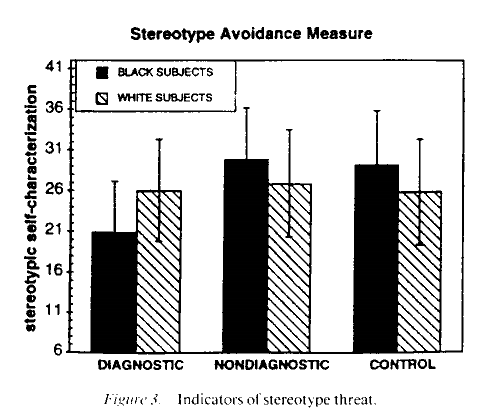心理学家克劳德·斯蒂尔(Claude Steele)和乔舒亚·阿伦森(Joshua Aronson)开发了一个比以上实验更加极端的版本。他们选取的实验对象是数名黑人大学生,道具则是从美国研究生入学考试(GRE)中抽取的20道题。按照要求,学生们在试前问卷上填写了所属人种,这一简单的动作就足以诱导他们联想到所有与美国黑人有关的消极形象,而他们的成绩以及答对题目的数量都削减了一半。
在当今社会,我们认为考试是考生能力和知识的可靠指标,因此将寄予考试以重托。但事实果真如此吗?如果在学术能力评估测试(SAT)中,一位出身名牌私立高中的白人学生的分数高于一位来自公立学校的黑人学生,那么这到底是因为白人学生着实更加优秀呢,还是因为身为白人又出身名校的学生时常头顶着“天资聪颖”的光环呢?
令人更为称奇的是,这些诱导因素影响我们的方式是如此神秘莫测,让人难以察觉。当你在做上文中的造句测试时,你并不知道自己正在被灌输着有关“衰老”的思想吧。但话说回来,这些诱导因素是如此隐秘,你又怎会察觉呢?然而值得注意的是,人们在缓步走出房间、穿过走廊之后,仍然对自己行为受到的影响浑然不知。
巴格曾让实验对象玩棋类游戏,其中,参与者获胜的唯一方式是通过相互合作。巴格通过诱导向参与者灌输了协作精神,果不其然,这些人配合的默契程度大大提升,游戏的进行也顺利了许多。巴格指出:“事后,我们向实验对象提了一些问题,比如,你在游戏中与人团结得有多紧密?你有多愿意与人合作?然后,我们将答案与他们的实际行为做了比较,却发现二者毫无相关性。这个游戏时长15分钟,但游戏过后,人们竟对自己在游戏中的协作表现一无所知。他们都没有回过神来,给出的答案也都是瞎答一通的无用信息。这真让我感到出乎意料,我还以为他们起码能从回忆里琢磨出点儿什么来呢,但他们没有。”在上文的实验中,当黑人学生注意到自己的人种后,他们在考试中表现得一塌糊涂。阿伦森和斯蒂尔在他们身上发现了与棋类游戏实验对象同样的问题。阿伦森说:“考试后,我与黑人学生交谈。我问道:‘有没有什么因素影响了你们的发挥?’我还问他们:‘我让你们在试卷上说明你所属的人种,这会不会对你们产生干扰?’因为,这显然对他们的表现有很大的影响。但他们却总回答说自己并不介意,还说,‘你知道吗,我觉得我不够聪明,不配待在这儿。’”
不难看出,这些实验的结果很值得我们警醒:我们一直看成自由意志的东西,在很大程度上只是个幻象。我们往往一直处在“自动驾驶”的心理状态中,我们的思考和行为方式,以及在紧急关头思考与行动的能力,比我们想象的要更易受到外部环境的影响。但与此同时我也认为,潜意识悄无声息的运作方式有其不容忽略的优势。在做上文中那个穿插着有关衰老字眼的乱句重组测试时,你在每个句子上各用了多长时间呢?依我看,每个句子的用时不会多过几秒钟吧。这速度已经挺快了,而你之所以能迅速完成测试,原因就在于你能够排除干扰,做到心无旁骛。如果你一直把心思花在单词列表中可能存在的规律上,那么,想要这么迅速地完成任务就试比登天了,因为你的思想没有集中。诚然,测试中涉及衰老的信息改变了你走出房间的速度,但这是件坏事吗?你的潜意识只是在通知身体:我察觉到了一些线索,我们正处于一个与衰老有所关联的环境中,让我们“随遇而安”,按环境需要而行动吧。如此说来,你的潜意识就像一个心理世界的仆从,精心照料着你思维生活中微妙的细枝末节,密切关注着你周围发生的一切,竭力确保你能够随机应变,同时给予你足够的自由空间,以便将注意力集中于亟待处理的事宜。
http://www.physics.emory.edu/~weeks/journal/steele-jpsp95.pdfSteele, C.M., & Aronson, J. (1995). Stereotype Threat and the intellectual test-performance of African-Americans.
Journal of personality and Social Psychology, 69 (5): 797-811.
Although the processes of stereotype activation and resulting patterns of prejudice had been heavily researched by the 1990’s, scientific explanation for the real differences in performance between racial and gender groups was lacking. Thus, the tradition of blaming group disparities on inherent differences between blacks and whites or men and women was still being echoed late into the twentieth century. Steele & Aronson’s (1995) research on Stereotype Threat was a sharp departure from this tradition. In what became a landmark study, black and white participants took a scholatic aptitude test, which was framed as either diagnostic of intellectual ability or as non-indicative of ability. Scores for participants in the ability condition reflected typical black/white disparities, but critically, scores from the non-ability condition did not: blacks performed just as well as whites. Additional manipulations in the study found that racial disparities in performance resulted from participants’ fears that they may confirm negative stereotypes about their group, and that this threat led to a decrease in performance. As such, even the mere salience of a stereotype could negatively impact performance when the related task could confirm or disconfirm the stereotype.
This is a classic article in social psychology as it was the first scientific research to show that differences in racial group performance are at least partially the result of social influence. The theory of Stereotype Threat has been repeatedly validated and replicated with many other social groups which are negatively stereotyped in specific domains (including women’s performance in math and white men’s athletic performance).www.psychspace.com心理学空间网


